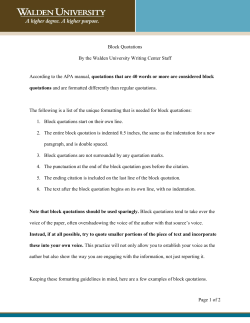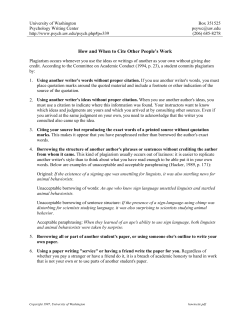
The dirtytalk Package M. Klammler November 21, 2010
The dirtytalk Package
M. Klammler∗
November 21, 2010
Abstract
This document explains the usage of the dirtytalk package for LATEX 2ε .
It can be used to typeset “quotations” more comfortable. The source code
is also explained.
Contents
1 Usage
2
1.1
Loading . . . . . . . . . . . . . . . . . . . . . . . . . . . . . . . .
2
1.2
Macros . . . . . . . . . . . . . . . . . . . . . . . . . . . . . . . . .
2
1.3
Options . . . . . . . . . . . . . . . . . . . . . . . . . . . . . . . .
2
2 Source Code Documentation
3
2.1
Identification . . . . . . . . . . . . . . . . . . . . . . . . . . . . .
3
2.2
Preliminary Declarations . . . . . . . . . . . . . . . . . . . . . . .
3
2.3
Options . . . . . . . . . . . . . . . . . . . . . . . . . . . . . . . .
4
2.4
More Declarations . . . . . . . . . . . . . . . . . . . . . . . . . .
4
3 Copyright Statement
5
∗ moritz.klammler∂student.kit.edu
(If you felt sad when Littlefoot’s mother died in theoriginal Land Before Time you’ll know
what the ∂ means. . . )
1
Who should use this package? Everybody who feels typesetting quotes in
LATEX could be more comfortable.
Who should really use this package? Everybody who typesets German
texts using \glqq{}Hallo Welt\grqq{} for a simple „Hallo Welt“ or — even
worse — those who already started writing a text using the same glyphs for
nested quotations and soon after find themselves in the embarrassing position
of replacing them while being no regexp whiz.
1
Usage
1.1
Loading
Put \usepackage{dirtytalk} in the preamble of your document.
1.2
\say
Macros
Loaded the package you can typeset quotations by \say{hello world} to get
“hello world”. Nested quotations are recognized as in:
1.3
Alice said: \say{Why did
you do that, Bob?}
Alice said: “Why did you do
that, Bob?”
And Bob answered: \say{
What do you mean with
\say{that}, dear Alice?}
And Bob answered: “What do
you mean with ‘that’, dear Alice?”
Options
The package can be loaded with a couple of options to alter the glyphs being
used. These are given in the key=value style.
key
default value
glyph
left
right
leftsub
rightsub
‘‘
’’
‘
’
“
”
‘
’
Table 1: Options for the dirtytalk package.
So my fellow German citizens might load the package with
2
\usepackage[%
left
= \glqq,%
right
= \grqq,%
leftsub = \glq,%
rightsub = \grq%
]{dirtytalk}
to get German glyphs. Pleas note that the package does not check your
document language to alter the symbols used. It depends on you as the author
to specify those you want.
Happy LATEXing!
2
Source Code Documentation
This section shows and explains the entire code of the package. (It is intended
for LATEX programmers only.)
2.1
1
2
Identification
\NeedsTeXFormat{LaTeX2e}
\ProvidesPackage{dirtytalk}[2010/11/21 A package making "quoting" easier]
2.2
Preliminary Declarations
We use options from the key=value type so we need to load a package supporting this:
3
\RequirePackage{kvoptions}
Define the glyphs that will enclose the phrases. We initially define them for
English which will probably be the most requested standard. If the package is
loaded with options, the following macros will be redefined.
\dirtytalk@lqq
Outer opening (left) quotation mark glyph.
4
\dirtytalk@rqq
Outer closing (right) quotation mark glyph.
5
\dirtytalk@lq
\newcommand{\dirtytalk@lqq}{‘‘}
\newcommand{\dirtytalk@rqq}{’’}
Inner opening (left) quotation mark glyph.
6
\newcommand{\dirtytalk@lq}{‘}
3
\dirtytalk@rq
Inner closing (right) quotation mark glyph.
7
\newcommand{\dirtytalk@rq}{’}
2.3
Options
We allow the author to specify own quotation mark glyphs instead of those
defined above by passing them as options.
\DeclareStringOption{left}
\DeclareStringOption{right}
10 \DeclareStringOption{leftsub}
11 \DeclareStringOption{rightsub}
8
9
12
\ProcessKeyvalOptions*
2.4
More Declarations
After processing the options (in case of the kvoptions’ string options that means
a macro has been defined holding the key value) we check if they are empty and,
if not so, redefine the default glyphs. For this task we need the ifthen package.
13
\RequirePackage{ifthen}
\ifthenelse%
{\equal{\dirtytalk@left}{}}%
16
{}%
17
{\renewcommand{\dirtytalk@lqq}{\dirtytalk@left}}
14
15
\ifthenelse%
{\equal{\dirtytalk@right}{}}%
20
{}%
21
{\renewcommand{\dirtytalk@rqq}{\dirtytalk@right}}
18
19
\ifthenelse%
{\equal{\dirtytalk@leftsub}{}}%
24
{}%
25
{\renewcommand{\dirtytalk@lq}{\dirtytalk@leftsub}}
22
23
\ifthenelse%
{\equal{\dirtytalk@rightsub}{}}%
28
{}%
29
{\renewcommand{\dirtytalk@rq}{\dirtytalk@rightsub}}
26
27
And we define a counter that represents the depth to which a quotation is
nested. However, we will only distinguish between “not nested” and “nested”
(dirtytalk@qdepth > 1). Since there is no convention for sub-sub-quotes. (At
least, I don’t know any.)
30
\newcounter{dirtytalk@qdepth}
4
Using this counter, we can now determine which glyph we have to use.
\dirtytalk@lsymb
We define one macro for opening quotes:
\newcommand%
{\dirtytalk@lsymb}%
33
{\ifthenelse%
34
{\value{dirtytalk@qdepth}>1}%
35
{\dirtytalk@lq}%
36
{\dirtytalk@lqq}%
37
}%
31
32
\dirtytalk@rsymb
And one for closing quotes:
\newcommand{\dirtytalk@rsymb}%
{\ifthenelse%
40
{\value{dirtytalk@qdepth}>1}%
41
{\dirtytalk@rq}%
42
{\dirtytalk@rqq}%
43
}
38
39
\say
And so finally we can declare the only macro this package provides to the author.
On opening quotes we increment the dirtytalk@qdepth counter and decrement
it on closing ones. The appropriate glyph is obtained form \dirtytalk@lsymb
or \dirtytalk@rsymb respectively.
\providecommand{\say}[1]%
{%
46
\addtocounter{dirtytalk@qdepth}{1}%
47
\dirtytalk@lsymb%
48
#1%
49
\dirtytalk@rsymb%
50
\addtocounter{dirtytalk@qdepth}{-1}%
51
}
44
45
3
Copyright Statement
I, the copyright holder of this work, release the source code of the dirtytalk
package as well as this documentation into the public domain. This applies
worldwide.
In some countries this may not be legally possible; if so: I grant anyone
the right to use this work for any purpose, without any conditions, unless such
conditions are required by law.
5
© Copyright 2025





















